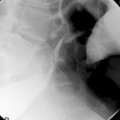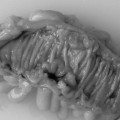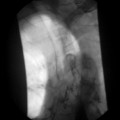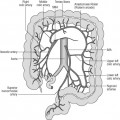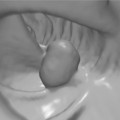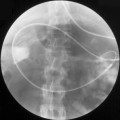CHAPTER 1 Evolving practice and shifting boundaries in gastrointestinal tract imaging
Advances in GI imaging
CT has been the mainstay of staging for most GI cancers, although we are seeing an increasing role for ultrasound and magnetic resonance (MR) imaging, particularly in peri-rectal imaging. PET (positron emission tomography) and hybrid scanning methods are also likely to have an expanding role in the assessment of more complex cases, particularly in the investigation of cancer recurrence or identification of an unknown primary cancer.
Shifting professional boundaries
The gradual refinement of fluoroscopic techniques, coupled with the progressive exploration of new imaging modalities, has resulted in a much wider contribution of radiology to the gastrointestinal (GI) patient care pathway. Over the last three decades, there has been a huge shift in the role of the professions that are involved in providing the GI radiology service, particularly in the UK (Nightingale and Hogg, 2003a, 2007). However, the UK is not alone in this, with gradually shifting professional boundaries being seen within other English-speaking countries, including the USA, Australia, New Zealand and Canada.
The health services of the world are highly complex organizations, often being among the largest national employers. Introducing radical change into such organizations is challenging, as they often have many stakeholders with different needs to satisfy. Analysis of a number of historical role developments, both within and outside radiology, suggests that a range of overlapping drivers is necessary to implement the changes effectively (Box 1.1) (Nightingale and Hogg, 2003b). In the early 1990s, a major shift in professional roles began to take place within UK radiology departments. One of the most rapid to be adopted was the introduction of radiographer-performed double contrast barium enema (DCBE) examinations (known as the air contrast barium enema examination in the USA). The introduction of this role will be explored further, considering the relevant drivers that came together to result in successful implementation on a national scale.
A perceived deficiency in the service
According to the UK professional body, The College of Radiographers (2006), diagnostic imaging and interventional services have increased by 2.5–5% per annum over the last 10 to 12 years. This continuing rise in demand for imaging services, coupled with a shortage of radiologists, led to UK radiology services being severely over-stretched. The shortfall in radiologists was estimated by the Royal College of Radiologists in 2002 to:
Not surprisingly, perceived deficiencies were noted within the service. These included excessively long waiting times for complex examinations (including the DCBE) and radiological reports turned around too slowly to affect patient management, or not reported at all (Audit Commission, 1995). The DCBE examinations were often single reported, even when double reporting was considered to be best practice (Markus et al., 1990; Leslie and Virjee, 2002; Halligan et al., 2003). This raised serious concerns for patient care and the impact upon their prognoses, particularly where cancer was suspected. The shortage of radiologists also inevitably held back the further development of the service at that time, with less time available for audit, research and the introduction of new services.
A possible solution
Radiographers had expanded their pre-registration education to degree level (from a 2-year diploma course) and experienced radiographers had begun to explore postgraduate master’s level opportunities. Radiographers have long been perceived to be working below their potential (Swinburne, 1971), often moving into managerial or education positions due to a lack of challenging opportunities in clinical practice. One solution, to train radiographers to undertake DCBE examinations, as these had unacceptably long waiting lists in many hospitals, offered an important new challenge and yet could be ‘easily described within a protocol’ (Somers et al., 1981).
A legal framework within which to introduce the change
A number of changes to legislation and professional body guidance was introduced within the 1990s, some acting as a catalyst to encourage role development and some, inevitably, being brought about in response to what was already happening at a local level. These included the introduction of the Ionising Radiation (Medical Exposure) Regulations (Department of Health, 2000a) and Department of Health publications such as the NHS Cancer Plan (2000b). The professional body and trade union for radiographers (the Society and College of Radiographers) was very supportive to radiographers wishing to develop their roles, issuing a series of guidance documents between 1996 and the present day (e.g. The College of Radiographers 1996, 1997, 2006). In essence, these documents suggested a framework in which radiographers could potentially develop any role, as long as they were appropriately trained, worked within agreed protocols, audited their practice and maintained their competence through continuing professional development (CPD). Protocols have been found to be appropriate frameworks within which radiographers can safely and effectively practice advanced roles (Nightingale, 2008). The Royal College of Radiologists (RCR; the UK radiologists’ professional body) has also been supportive towards radiographer role development, although with a slightly more cautious approach (RCR 1996, 1999, 2007). This is understandable when their members are delegating existing tasks and may still bear the ultimate responsibility for the delegated role.
A ‘champion’ of the change, at national and local level
There has to date been no direct professional body steer to introduce a particular role development across the UK. However, as with most new roles, there is often a champion at national level. For the introduction of radiographer-performed DCBE, this champion has arguably been the national gastrointestinal radiographers’ special interest group (GIRSIG), which has both promoted and supported radiographers involved in these roles for several years (Nightingale and Hogg, 2000). However, it is not clear if the role would have been introduced so successfully across the UK if it had not been for the presence of radiologist champions, promoting radiographer role development both within and beyond radiology (e.g. Chapman, 1997; Robinson et al., 1999; Thomas, 2005b). The radiologists appeared at that time to be the ‘gatekeepers’ to service development and this largely appears to be the case today. The radiologists provided clinical training and supervision for the radiographers, who had access to a short course or Master’s level module for theoretical underpinning.
National drivers for role development have also emerged in the wake of a series of government targets, most notably the introduction of a maximum waiting target of 2 weeks from referral to diagnosis for suspected cancer (NHS Executive, 2000) and, more recently, the 18 week maximum from referral to treatment (Department of Health, 2006). With medical imaging being heralded by the Government as the primary bottleneck resulting in failure of hospitals to meet these targets (Department of Health, 2005), it is little wonder that modernizing services and new ways of working are being championed in political circles.
Evidence (research) that the change will be effective
Published evidence that the role change is effective is vital to promote the widespread introduction of a new service. While UK radiographers have been rather reticent to engage in research, where the DCBE examination has been concerned, one finds a wealth of literature supporting the new role. This has included a number of studies comparing radiographer performance in performing and/or reporting DCBE examinations with trainee radiologists (Mannion et al., 1995; Schreiber et al., 1996; Davidson et al., 2000) or with consultant radiologists (McKenzie et al., 1998; Culpan et al., 2002; Murphy et al., 2002; Vora and Chapman, 2004). It also includes performance against pathology databases (Law et al., 1999, 2008) and national surveys of practice (Bewell and Chapman, 1996). While most of these studies have concentrated on small numbers of individuals in single-center studies, they nevertheless provide very useful and plausible performance data across large numbers of patients.
A benefit to stakeholders (interested parties)
However, without there being a clear benefit to the relevant stakeholders, it is unlikely that a new role will be introduced. The benefits to radiology departments have been clear, with vastly reduced waiting lists for DCBE and, where radiographer reporting has been introduced, quicker turnaround for report writing. There are potential cost savings, with the hourly rate of a radiographer being considerably less than that of a consultant radiologist (Brown and Desai, 2002). Surprisingly little published literature is focused upon patient acceptability, although in practice many unpublished patient surveys have suggested that patients are happy to be cared for by a radiographer without recourse to a radiologist. The patient benefits directly from these improvements, reducing anxiety with shorter waits and having a potentially better prognosis associated with a shortened referral to diagnosis timeframe. The benefits to the radiologist are clear, in that they have more time to fulfil their other duties or to introduce new services. Anecdotal evidence would suggest that, for most radiologists, the rather unglamorous aspects of the DCBE procedure have not been missed from their portfolio of duties!
Beyond the DCBE
The radiographer-performed DCBE role has been so well received that radiographer-led services are now the norm across the UK National Health Service (NHS), with recent estimates suggesting that over 1200 radiographers have been trained to perform DCBE (Nightingale and Hogg, 2007); 82% of hospitals surveyed by Price and Le Masurier (2007) had implemented a radiographer-led DCBE service. Many such radiographers have gone on to undertake postgraduate training to enable them to write an official report on the DCBEs, with published data supporting this practice (Law et al., 1999; Murphy et al., 2002). While most of the available courses prepare and assess radiographers to report independently, in practice, many will report as part of a double reporting system, whereby two people view the images independently and then compare reports. Double reporting is recommended in the UK for the DCBE procedure, as it is associated with a high level of potential perception errors (Markus et al., 1990; Leslie and Virjee, 2002).
Some radiographers have further expanded their role to perform and report barium swallows and meals, videofluoroscopy swallowing assessments, small bowel studies, proctograms and other non-GI fluoroscopy (e.g. hysterosalpingography) (Law et al., 2005; Nightingale and Mackay, 2009). While most DCBE radiographers have further developed their role within the confines of the fluoroscopy room, increasingly GI radiographers are crossing traditional imaging modalities to run a CT colonography service, often in conjunction with a CT radiographer. Some are not only working across imaging modalities, but have also crossed professional boundaries to work with teams outside radiology. Although nurse-performed endoscopy is far more common (Maruthachalam et al., 2006, Kelly et al., 2007), a handful of UK radiographers have trained to undertake sigmoidoscopy or colonoscopy, with the potential advantage over nurses of being able to offer continuity of care with combined DCBE and direct visualization on one day.
However, despite the exciting opportunities presented, relatively few UK radiographers have developed their role beyond the DCBE examination (Price and Le Masurier, 2007). This may be because the required drivers for effective role changes (see Box 1.1.) are not firmly in place. In Table 1.1
Stay updated, free articles. Join our Telegram channel

Full access? Get Clinical Tree
















